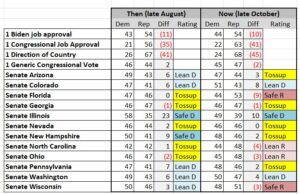America is now in the home stretch: just an hour ago (as this article is being published), Louisiana was the first state to have concluded its in person early voting, and other states will shortly follow Louisiana’s lead. And with a week to go, control of the Senate remains tight, but polling trends have demonstrably been in once direction since late August.
Scorecard Criteria
Publicly available polling data for all Senate races has been compiled for October 24-November 1, and polling data has since late August been available for JMC’s review. As polling data is compiled for a given time period, it is then averaged for each Senate race, and with the average poll showing for each candidate, here’s how JMC rates each race:
(1) Safe Democratic/Republican – A candidate either has a polling average of at least 50% and/or at least a 10-point lead in the polls;
(2) Lean Democratic/Republican – A candidate has a 3–9-point lead in the polls;
(3) Tossup – A candidate’s lead is less than 3 points in the polls;
JMC’s 11/1 Scorecard
As we move into the homestretch, what’s immediately apparent when comparing polling data in late August to late October data is what’s changed and what hasn’t. The fundamentals (President Biden’s approval, Congressional job approval, and Direction of the Country) have barely changed in two months. And that’s NOT a data point Democrats would like to see.
The one metric that matters the most, however (Generic Congressional Ballot) has shifted 4 points towards Republicans in two months’ time (from 46-44% Dem/Rep to 47-45% Rep/Dem), and that shift has similarly shown up in individual Senate races. There are currently five tossup races. Four of them are currently held by the Democrats (Arizona, Georgia, Nevada, and New Hampshire – New Hampshire has literally tightened in the last few weeks, and New Hampshire has minimal early voting).
The bottom line: while Democrats have a 50-50 tie in the Senate, polling averages since October 24 show Republicans ahead in 49 seats, while Democrats are ahead in 46 seats. Republicans just need to win 2 of these 5 tossup races, while Democrats need to win all 5 to take actual numerical control of the US Senate.
And even though the Washington Senate contest showed Democrats comfortably ahead in the state’s nonpartisan primary in August, this race has noticeably tightened since then, and with a week more to go, it’s a race at least worth watching. Although unlike New Hampshire, Washington is a vote by mail state, and as of press time, 17%/over 800K of the state’s registered voters have already voted.
Early voting
While Election Day itself isn’t until November 8, in person early voting is at its peak, and now that Louisiana has concluded its early voting, other states will follow. Currently, we show 27,002,721 have early voted, and that number is currently incrementing by several million voters a day. What’s worth noting here is that while Democrats (thanks to 61% of that vote so far coming from mail in voting) have a 46-34% lead in terms of party registration of the voter, it was 47-32% Democratic at a similar point in time in 2020. Plus, this year’s early voting volume is 60% lower than it was in 2020, which we believe is a greater than normal drop-off from a Presidential to a midterm election cycle.
Why do these early voting numbers matter ? As mentioned in this analysis, 72% of the vote was cast before Election Day, and even considering that some of that was caused by the pandemic’s changing voting behavior (whether voluntarily or by government decree), JMC believes that there has been a permanent shift to some extent of people wanting to “get it over with” and vote before Election Day. This mindset WILL affect when people are making up their mind about who to vote for, and both candidates/consultants would be wise to take this new paradigm into consideration when planning their messaging/get out the vote efforts.

